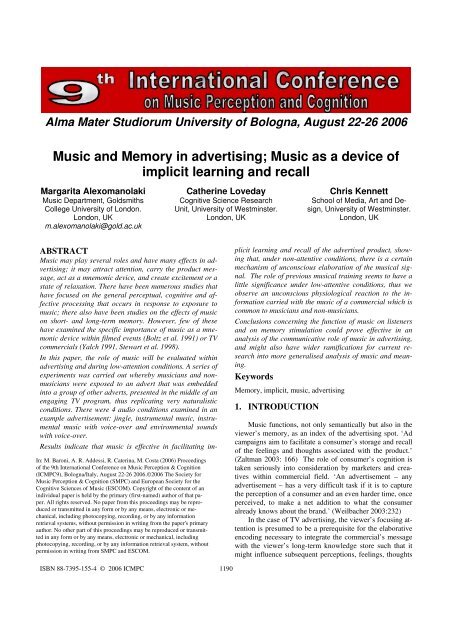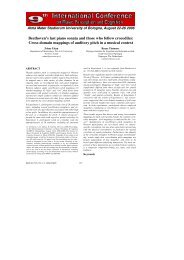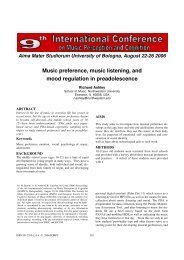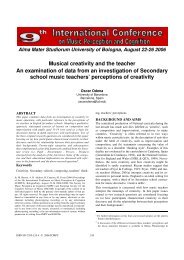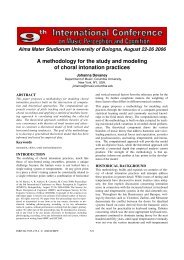Music and Memory in advertising; Music as a ... - Prof. Marco Costa
Music and Memory in advertising; Music as a ... - Prof. Marco Costa
Music and Memory in advertising; Music as a ... - Prof. Marco Costa
Create successful ePaper yourself
Turn your PDF publications into a flip-book with our unique Google optimized e-Paper software.
Alma Mater Studiorum University of Bologna, August 22-26 2006<br />
<strong>Music</strong> <strong>and</strong> <strong>Memory</strong> <strong>in</strong> advertis<strong>in</strong>g; <strong>Music</strong> <strong>as</strong> a device of<br />
implicit learn<strong>in</strong>g <strong>and</strong> recall<br />
Margarita Alexomanolaki<br />
<strong>Music</strong> Department, Goldsmiths<br />
College University of London.<br />
London, UK<br />
m.alexomanolaki@gold.ac.uk<br />
Cather<strong>in</strong>e Loveday<br />
Cognitive Science Research<br />
Unit, University of Westm<strong>in</strong>ster.<br />
London, UK<br />
Chris Kennett<br />
School of Media, Art <strong>and</strong> Design,<br />
University of Westm<strong>in</strong>ster.<br />
London, UK<br />
ABSTRACT<br />
<strong>Music</strong> may play several roles <strong>and</strong> have many effects <strong>in</strong> advertis<strong>in</strong>g;<br />
it may attract attention, carry the product message,<br />
act <strong>as</strong> a mnemonic device, <strong>and</strong> create excitement or a<br />
state of relaxation. There have been numerous studies that<br />
have focused on the general perceptual, cognitive <strong>and</strong> affective<br />
process<strong>in</strong>g that occurs <strong>in</strong> response to exposure to<br />
music; there also have been studies on the effects of music<br />
on short- <strong>and</strong> long-term memory. However, few of these<br />
have exam<strong>in</strong>ed the specific importance of music <strong>as</strong> a mnemonic<br />
device with<strong>in</strong> filmed events (Boltz et al. 1991) or TV<br />
commercials (Yalch 1991, Stewart et al. 1998).<br />
In this paper, the role of music will be evaluated with<strong>in</strong><br />
advertis<strong>in</strong>g <strong>and</strong> dur<strong>in</strong>g low-attention conditions. A series of<br />
experiments w<strong>as</strong> carried out whereby musicians <strong>and</strong> nonmusicians<br />
were exposed to an advert that w<strong>as</strong> embedded<br />
<strong>in</strong>to a group of other adverts, presented <strong>in</strong> the middle of an<br />
engag<strong>in</strong>g TV program, thus replicat<strong>in</strong>g very naturalistic<br />
conditions. There were 4 audio conditions exam<strong>in</strong>ed <strong>in</strong> an<br />
example advertisement: j<strong>in</strong>gle, <strong>in</strong>strumental music, <strong>in</strong>strumental<br />
music with voice-over <strong>and</strong> environmental sounds<br />
with voice-over.<br />
In: M. Baroni, A. R. Addessi, R. Cater<strong>in</strong>a, M. <strong>Costa</strong> (2006) Proceed<strong>in</strong>gs<br />
of the 9th International Conference on <strong>Music</strong> Perception & Cognition<br />
(ICMPC9), Bologna/Italy, August 22-26 2006.©2006 The Society for<br />
<strong>Music</strong> Perception & Cognition (SMPC) <strong>and</strong> European Society for the<br />
Cognitive Sciences of <strong>Music</strong> (ESCOM). Copyright of the content of an<br />
<strong>in</strong>dividual paper is held by the primary (first-named) author of that paper.<br />
All rights reserved. No paper from this proceed<strong>in</strong>gs may be reproduced<br />
or transmitted <strong>in</strong> any form or by any means, electronic or mechanical,<br />
<strong>in</strong>clud<strong>in</strong>g photocopy<strong>in</strong>g, record<strong>in</strong>g, or by any <strong>in</strong>formation<br />
retrieval systems, without permission <strong>in</strong> writ<strong>in</strong>g from the paper's primary<br />
author. No other part of this proceed<strong>in</strong>gs may be reproduced or transmitted<br />
<strong>in</strong> any form or by any means, electronic or mechanical, <strong>in</strong>clud<strong>in</strong>g<br />
photocopy<strong>in</strong>g, record<strong>in</strong>g, or by any <strong>in</strong>formation retrieval system, without<br />
permission <strong>in</strong> writ<strong>in</strong>g from SMPC <strong>and</strong> ESCOM.<br />
Results <strong>in</strong>dicate that music is effective <strong>in</strong> facilitat<strong>in</strong>g implicit<br />
learn<strong>in</strong>g <strong>and</strong> recall of the advertised product, show<strong>in</strong>g<br />
that, under non-attentive conditions, there is a certa<strong>in</strong><br />
mechanism of unconscious elaboration of the musical signal.<br />
The role of previous musical tra<strong>in</strong><strong>in</strong>g seems to have a<br />
little significance under low-attentive conditions, thus we<br />
observe an unconscious physiological reaction to the <strong>in</strong>formation<br />
carried with the music of a commercial which is<br />
common to musicians <strong>and</strong> non-musicians.<br />
Conclusions concern<strong>in</strong>g the function of music on listeners<br />
<strong>and</strong> on memory stimulation could prove effective <strong>in</strong> an<br />
analysis of the communicative role of music <strong>in</strong> advertis<strong>in</strong>g,<br />
<strong>and</strong> might also have wider ramifications for current research<br />
<strong>in</strong>to more generalised analysis of music <strong>and</strong> mean<strong>in</strong>g.<br />
Keywords<br />
<strong>Memory</strong>, implicit, music, advertis<strong>in</strong>g<br />
1. INTRODUCTION<br />
<strong>Music</strong> functions, not only semantically but also <strong>in</strong> the<br />
viewer’s memory, <strong>as</strong> an <strong>in</strong>dex of the advertis<strong>in</strong>g spot. ‘Ad<br />
campaigns aim to facilitate a consumer’s storage <strong>and</strong> recall<br />
of the feel<strong>in</strong>gs <strong>and</strong> thoughts <strong>as</strong>sociated with the product.’<br />
(Zaltman 2003: 166) The role of consumer’s cognition is<br />
taken seriously <strong>in</strong>to consideration by marketers <strong>and</strong> creatives<br />
with<strong>in</strong> commercial field. ‘An advertisement – any<br />
advertisement – h<strong>as</strong> a very difficult t<strong>as</strong>k if it is to capture<br />
the perception of a consumer <strong>and</strong> an even harder time, once<br />
perceived, to make a net addition to what the consumer<br />
already knows about the br<strong>and</strong>.’ (Weilbacher 2003:232)<br />
In the c<strong>as</strong>e of TV advertis<strong>in</strong>g, the viewer’s focus<strong>in</strong>g attention<br />
is presumed to be a prerequisite for the elaborative<br />
encod<strong>in</strong>g necessary to <strong>in</strong>tegrate the commercial’s message<br />
with the viewer’s long-term knowledge store such that it<br />
might <strong>in</strong>fluence subsequent perceptions, feel<strong>in</strong>gs, thoughts<br />
ISBN 88-7395-155-4 © 2006 ICMPC 1190
ICMPC9 Proceed<strong>in</strong>gs<br />
<strong>and</strong> actions. ‘The crucial challenge for advertis<strong>in</strong>g, <strong>and</strong> all<br />
sponsored market<strong>in</strong>g communications about br<strong>and</strong>s, is what<br />
consumers can be made to learn about the br<strong>and</strong> that transcends<br />
its transactional qualities.’ (Weilbacher 2003:234)<br />
<strong>Music</strong> <strong>and</strong> sound <strong>in</strong> advertis<strong>in</strong>g are not used merely<br />
because the means of television allows <strong>as</strong> this extra option<br />
added on image. Firstly, the image attracts attention <strong>and</strong><br />
explicit recognition, elaboration, <strong>as</strong>sociation, learn<strong>in</strong>g <strong>and</strong><br />
recall of the advertised product – without exclud<strong>in</strong>g any<br />
implicit function of the recipient by the above <strong>as</strong>sertion. It<br />
is not the c<strong>as</strong>e, however, that all memory retrieval is explicit<br />
<strong>in</strong> nature; decisions can also be <strong>in</strong>fluenced by implicit<br />
memories. Market<strong>in</strong>g research h<strong>as</strong> showed that unconscious<br />
reactions to market<strong>in</strong>g stimuli are more accurate<br />
<strong>in</strong>dicators of actual thought – <strong>and</strong> subsequent behaviour –<br />
than the conscious reports consumers often provide<br />
(Shapiro et al. 2001, Zaltman 2003). Thus, image does not<br />
efficiently aid implicit or unconscious learn<strong>in</strong>g, <strong>and</strong> recall<br />
<strong>in</strong> c<strong>as</strong>e they occur, <strong>in</strong> the same way music does not efficiently<br />
aid explicit learn<strong>in</strong>g <strong>and</strong> attention, unless under<br />
directed guidance <strong>and</strong> <strong>in</strong>vigilation.<br />
Research shows that attention dur<strong>in</strong>g television view<strong>in</strong>g<br />
is very sensitive; both program <strong>and</strong> commercial view<strong>in</strong>g<br />
often take place among myriad other activities (Krugman<br />
et al. 1995). Therefore the viewers’ visual attention<br />
might secede from watch<strong>in</strong>g the television screen. In this<br />
c<strong>as</strong>e auditory stimuli function <strong>as</strong> <strong>in</strong>formative cues to either<br />
guide visual attention back to the television screen (Anderson<br />
1983) or transmit orally the ‘visual’ message of the<br />
actual commercial (Krugman et al.1995, Morgan et al.<br />
2002).<br />
The successful relationship between music <strong>and</strong> image<br />
is acknowledged by film studies; to quote from Kall<strong>in</strong>ak<br />
1992 on the effectiveness of music <strong>in</strong> films: ‘<strong>Music</strong>al accompaniment<br />
w<strong>as</strong> thus positioned to effect perception, especially<br />
the semiconscious, without disrupt<strong>in</strong>g narrative<br />
credibility.’ (Kall<strong>in</strong>ak 1992: 86) Boltz 1991 identified with<br />
the above: ‘<strong>Music</strong> can accentuate various qualities of visual<br />
activities <strong>and</strong> thereby enhance their perceptual salience.’<br />
(Boltz et al, 1991: 594) Cohen 2001 re<strong>in</strong>forces the above<br />
by <strong>as</strong>sert<strong>in</strong>g that the simultaneous presentation of music<br />
<strong>and</strong> film automatically elicits bottom-up pr<strong>in</strong>ciples that<br />
entail perceptual group<strong>in</strong>g <strong>in</strong> both auditory <strong>and</strong> visual doma<strong>in</strong>s.<br />
Kellaris’s et al. 1993 study on the effect of background<br />
music on advert process<strong>in</strong>g, also found that image-music<br />
congruency re<strong>in</strong>forced consumer’s memory <strong>and</strong> attention.<br />
Stewart et al. 1998 tested the extent to which different<br />
types of retrieval cues elicited different types of responses<br />
<strong>as</strong> a part of a larger advertis<strong>in</strong>g track<strong>in</strong>g project. The study<br />
showed that the image <strong>in</strong>teraction with music is more effective<br />
<strong>in</strong> retrieval than image <strong>in</strong>teraction with verbal <strong>in</strong>formation.<br />
2. Implicit <strong>Memory</strong> <strong>and</strong> <strong>Music</strong> <strong>in</strong> Advertis<strong>in</strong>g<br />
Early studies of Krishnan et al. 1996 revealed that implicit<br />
memory effects are cont<strong>in</strong>gent on a m<strong>in</strong>imum level of<br />
process<strong>in</strong>g; <strong>and</strong> also marketers should consider the role of<br />
implicit memory when <strong>as</strong>sess<strong>in</strong>g effectiveness of a br<strong>and</strong><br />
name or an ad campaign. Shapiro et al. later study, confirmed<br />
the aforementioned: ‘In the same condition <strong>in</strong> which<br />
explicit memory retrieval failed […], implicit memory retrieval<br />
led to an <strong>in</strong>cre<strong>as</strong>ed likelihood of choos<strong>in</strong>g the target<br />
br<strong>and</strong>s.’ (Shapiro et al. 2001:10)<br />
Pham <strong>and</strong> colleagues favoured implicit (<strong>in</strong>direct) memory<br />
tests, <strong>as</strong> more effective than explicit (direct) ones <strong>in</strong> the<br />
field of market<strong>in</strong>g, for <strong>as</strong>sess<strong>in</strong>g the unconscious learn<strong>in</strong>g<br />
<strong>and</strong> recall dur<strong>in</strong>g commercials: ‘Indirect memory tests may<br />
be more adequate because they <strong>as</strong>sess whether a learn<strong>in</strong>g<br />
episode (e.g. exposure to br<strong>and</strong> fragments) facilitates the performance<br />
t<strong>as</strong>k (e.g. answer<strong>in</strong>g questions about br<strong>and</strong> <strong>as</strong>sociations)<br />
without necessitat<strong>in</strong>g recollection of the learn<strong>in</strong>g episode.’ (Pham<br />
et al. 1997: 408)<br />
Although music seems to facilitate implicit learn<strong>in</strong>g<br />
<strong>and</strong> recall, little research h<strong>as</strong> been done, consider<strong>in</strong>g music<br />
<strong>as</strong> a ‘collaborative sign’. Studies on implicit memory <strong>and</strong><br />
music, focus ma<strong>in</strong>ly on unconscious recall of musical features<br />
(Halpern 2000, Tillman et al. 2000, 2004) <strong>and</strong> not on<br />
visual <strong>and</strong> verbal <strong>in</strong>formation carried by the ‘musical vehicle’.<br />
The latter, although recognized <strong>in</strong> anthropological <strong>and</strong><br />
ethnomusicological studies <strong>in</strong> children’s song (Black<strong>in</strong>g<br />
1995, M<strong>in</strong>ks 2002), is only mentioned <strong>as</strong> a cultural phenomenon<br />
of an orally transmitted tradition, <strong>and</strong> not further<br />
<strong>in</strong>vestigated <strong>as</strong> a feature of music with psychological <strong>and</strong><br />
physiological effects.<br />
Not many studies have <strong>in</strong>vestigated the role of music<br />
<strong>as</strong> a means of implicitly stor<strong>in</strong>g <strong>and</strong> recall<strong>in</strong>g <strong>in</strong>formation<br />
with<strong>in</strong> commercial context. Yalch’s 1991 empirical study<br />
on music <strong>as</strong> a mnemonic device <strong>in</strong> communicat<strong>in</strong>g advertis<strong>in</strong>g<br />
slogans, us<strong>in</strong>g both direct <strong>and</strong> <strong>in</strong>direct tests – albeit <strong>in</strong> a<br />
laboratory environment – concluded that music enhanced<br />
memory for advertis<strong>in</strong>g slogans when the slogans were<br />
<strong>in</strong>corporated <strong>in</strong>to an advertisement <strong>in</strong> the form of a j<strong>in</strong>gle<br />
or song; ‘slogan <strong>in</strong>formation presented with music appears<br />
e<strong>as</strong>ier to retrieve than similar <strong>in</strong>formation presented without<br />
music (Yalch 1991:273).<br />
In this paper the role of music <strong>in</strong> implicit learn<strong>in</strong>g <strong>and</strong><br />
recall will be evaluated with<strong>in</strong> advertis<strong>in</strong>g <strong>and</strong> dur<strong>in</strong>g lowattention<br />
conditions. A series of experiments w<strong>as</strong> carried<br />
out whereby musicians <strong>and</strong> non-musicians were exposed to<br />
an advert that w<strong>as</strong> embedded <strong>in</strong>to a group of other adverts,<br />
presented <strong>in</strong> the middle of an engag<strong>in</strong>g TV program, thus<br />
replicat<strong>in</strong>g very naturalistic conditions. There were 4 audio<br />
conditions exam<strong>in</strong>ed <strong>in</strong> an example advertisement: j<strong>in</strong>gle,<br />
<strong>in</strong>strumental music, <strong>in</strong>strumental music with voice-over<br />
<strong>and</strong> environmental sounds with voice-over.<br />
Hypotheses<br />
The first part of the <strong>in</strong>itial hypothesis is that music h<strong>as</strong><br />
a significant effect <strong>in</strong> re<strong>in</strong>forc<strong>in</strong>g implicit learn<strong>in</strong>g <strong>and</strong> re-<br />
ISBN 88-7395-155-4 © 2006 ICMPC 1191
ICMPC9 Proceed<strong>in</strong>gs<br />
call of visual <strong>and</strong> verbal <strong>in</strong>formation <strong>in</strong> a TV commercial. 1. J<strong>in</strong>gle: this w<strong>as</strong> the orig<strong>in</strong>al version <strong>in</strong> English language.<br />
The music w<strong>as</strong> composed by Ilja Gort <strong>and</strong> the lyrics<br />
We also presume that there will be no difference <strong>in</strong> the<br />
memory performance between musician <strong>and</strong> non-musician were written by Publicis. The j<strong>in</strong>gle version <strong>in</strong> English w<strong>as</strong><br />
viewers of the TV commercial s<strong>in</strong>ce music acts <strong>as</strong> unconscious<br />
re<strong>in</strong>forcement of the learn<strong>in</strong>g <strong>and</strong> recall of <strong>in</strong>forma-<br />
made depend<strong>in</strong>g on the country of broadc<strong>as</strong>t.<br />
broadc<strong>as</strong>t globally – no change <strong>in</strong> language or music w<strong>as</strong><br />
tion.<br />
2. Instrumental <strong>Music</strong>: this version had no verbal<br />
stimulus <strong>and</strong> it w<strong>as</strong> re<strong>in</strong>forced only by <strong>in</strong>strumental music.<br />
The music w<strong>as</strong> composed by Loukianos Kelaidonis <strong>in</strong> 1988<br />
3. METHOD<br />
for a Nescafé TV advertisement broadc<strong>as</strong>t <strong>in</strong> Greece only.<br />
3.1 Participants<br />
It w<strong>as</strong> chosen because it had similar rhythm to the orig<strong>in</strong>al<br />
N<strong>in</strong>ety-five participants, (39 males, 56 females) <strong>and</strong><br />
j<strong>in</strong>gle, so it fitted e<strong>as</strong>ily to the pace of image edit<strong>in</strong>g of the<br />
aged 18-30 (mean age: 22.2), were recruited from a variety<br />
advert, <strong>and</strong> it had been used for the same product <strong>and</strong><br />
of undergraduate courses of Goldsmiths University of London<br />
<strong>and</strong> University of Westm<strong>in</strong>ster to participate <strong>in</strong> this<br />
br<strong>and</strong>, thus, it w<strong>as</strong> a musical piece approved by the ‘creatives’<br />
of the advert for the same br<strong>and</strong>, to re<strong>in</strong>force the<br />
t<strong>as</strong>k. In return they were offered free snacks <strong>and</strong> dr<strong>in</strong>ks. 45<br />
video of the commercial. Therefore this music accomplished<br />
both semantic <strong>and</strong> formal congruency (Iwamiya<br />
of them were undergraduate students of <strong>Music</strong> Department<br />
at Goldsmiths College, all of whom were cl<strong>as</strong>sically tra<strong>in</strong>ed<br />
2002) with the image.<br />
musicians; 50 were non- musicians, undergraduate students<br />
3. <strong>Music</strong> <strong>and</strong> Voice Over: this version conta<strong>in</strong>ed the<br />
of the School of Computer Sciences <strong>and</strong> the School of Media,<br />
Art <strong>and</strong> Design, at the University of Westm<strong>in</strong>ster.<br />
<strong>in</strong>strumental music used for the previous version, plus<br />
voice over. The words for the voiceover were chosen from<br />
the lyrics of the orig<strong>in</strong>al j<strong>in</strong>gle, accentuat<strong>in</strong>g on the slogan<br />
3.2 Materials<br />
(Open up). The voice over w<strong>as</strong> chosen to be materialized<br />
by female voice, s<strong>in</strong>ce the orig<strong>in</strong>al j<strong>in</strong>gle w<strong>as</strong> sung by<br />
Target Material<br />
woman <strong>as</strong> well. In this way we m<strong>in</strong>imized frequency (Hz)<br />
The target material w<strong>as</strong> an advert presented with<strong>in</strong> a 3 differences <strong>in</strong> the verbal material between the orig<strong>in</strong>al <strong>and</strong><br />
m<strong>in</strong> commercial break of a 20 m<strong>in</strong> episode of the popular the current version, <strong>in</strong> order to avoid differences <strong>in</strong> the degree<br />
of attention stimulation <strong>as</strong> it w<strong>as</strong> <strong>in</strong>dicated by litera-<br />
US TV sit-com “Friends”. The break <strong>in</strong>cluded 4 adverts, 2<br />
well known to British audience, <strong>and</strong> 2 unfamiliar to the ture <strong>in</strong> previous chapters.<br />
broad British audience.<br />
4. Sound Effects <strong>and</strong> Voice Over: this version conta<strong>in</strong>ed<br />
no music <strong>and</strong> functioned <strong>as</strong> control version. It con-<br />
The target material w<strong>as</strong> a version of Nescafé advertis<strong>in</strong>g<br />
spot used <strong>in</strong> the current experiment w<strong>as</strong> part of the ta<strong>in</strong>ed sound effects <strong>and</strong> the same voice over <strong>as</strong> Version 3<br />
Open-Up Nescafé global campaign <strong>in</strong> 1998 with commercials<br />
shot <strong>and</strong> broadc<strong>as</strong>t over several months, all over the verbal context phonetically <strong>and</strong> semantically. The audio<br />
so all the versions with verbal <strong>in</strong>formation had the same<br />
world 1 . This version <strong>and</strong> the specific product were considered<br />
suitable for two re<strong>as</strong>ons: firstly for the cultural, age, (1994:75) ambient sounds that corresponded to the scener-<br />
effects were environmental sounds or, accord<strong>in</strong>g to Chion<br />
sex, race boundary-less profile it broadc<strong>as</strong>ts on a broadly ies showed <strong>in</strong> the advert; for example, when there w<strong>as</strong> a<br />
used product <strong>and</strong> secondly for be<strong>in</strong>g so shortly broadc<strong>as</strong>t <strong>in</strong> scene with two people by the beach, the audio w<strong>as</strong> the<br />
UK – more specifically Northern Irel<strong>and</strong> – mak<strong>in</strong>g it sound of waves, which matched the scene, both semantically<br />
<strong>and</strong> formally (Iwamiya 2002), <strong>as</strong> if it were the natural<br />
unlikely to be familiar to the participants. Familiarity w<strong>as</strong><br />
an important issue <strong>in</strong> the current experiment, s<strong>in</strong>ce we are sound dur<strong>in</strong>g film<strong>in</strong>g.<br />
test<strong>in</strong>g implicit learn<strong>in</strong>g. The participants confirmed their Each version of the target stimulus w<strong>as</strong> presented<br />
unfamiliarity with either the video or the audio part of the with<strong>in</strong> the advert break of the same episode of ‘Friends’ <strong>in</strong><br />
version used for the target stimulus. The <strong>in</strong>clusion of a second<br />
unfamiliar advert w<strong>as</strong> to avoid the factor of ‘surprise’<br />
the same order <strong>and</strong> with the same distractor adverts.<br />
<strong>and</strong> so that the participants’ attention would not be attracted<br />
to the target stimulus. On the other h<strong>and</strong>, if all the <strong>Memory</strong> Test<br />
adverts had been unfamiliar, it would not have been replicat<strong>in</strong>g<br />
natural conditions for the experiment, s<strong>in</strong>ce it is not lowed the view<strong>in</strong>g <strong>and</strong> <strong>in</strong>cluded 3 sections. Section 1 tested<br />
A pen <strong>and</strong> paper test presented <strong>in</strong> a s<strong>in</strong>gle package fol-<br />
likely that a commercial break on TV would <strong>in</strong>volve only the overall explicit memory for the episode of Friends (direct<br />
test). Section 2 tested implicit memory for the advert<br />
new - unfamiliar adverts. Therefore the proportion of two<br />
familiar <strong>and</strong> two unfamiliar adverts seemed re<strong>as</strong>onable. (<strong>in</strong>direct test). Section 3 tested explicit memory for the advert<br />
(direct test).<br />
The target stimulus - Nescafé advert - w<strong>as</strong> produced <strong>in</strong><br />
four different audio versions:<br />
Section 1. Overall memory test: <strong>in</strong>cluded 6 free-recall<br />
questions regard<strong>in</strong>g the plot of the episode broadc<strong>as</strong>t. In<br />
order to test participants’ overall memory <strong>and</strong> attention the<br />
questions were carefully chosen so the answers would be<br />
1 Source: http://www.nescafe.com/ma<strong>in</strong>_nest.<strong>as</strong>p<br />
ISBN 88-7395-155-4 © 2006 ICMPC 1192
ICMPC9 Proceed<strong>in</strong>gs<br />
retrieved from the beg<strong>in</strong>n<strong>in</strong>g, middle <strong>and</strong> the end of each<br />
parts of the episode, before <strong>and</strong> after the commercial break<br />
Section 2. Indirect Tests: Question 1 of Section 2<br />
tested implicit memory performance <strong>in</strong> relation to verbal<br />
material <strong>as</strong>sociated with advert. Participants were given a<br />
list of twelve words, three relevant to the visual part of the<br />
advert (gold, child, sea) three relevant to the product (cup,<br />
dr<strong>in</strong>k, spoon) <strong>and</strong> six neutral both to the group of adverts<br />
broadc<strong>as</strong>t <strong>and</strong> the show. They were <strong>as</strong>ked to listen to a fivesecond<br />
fragment of the target stimulus music or effects -<br />
depend<strong>in</strong>g on the version of Nescafé they had seen earlier<br />
<strong>and</strong> without any voice over <strong>in</strong> all c<strong>as</strong>es, - <strong>and</strong> tick the three<br />
words from the list that seemed to them more naturally<br />
<strong>as</strong>sociated with this music. They were <strong>as</strong>ked their spontaneous<br />
reaction <strong>and</strong> had approximately fifteen seconds to<br />
complete this t<strong>as</strong>k. By the end of this t<strong>as</strong>k, they were <strong>as</strong>ked<br />
if they had recognized the five-second audio version they<br />
had heard.<br />
Question 2 of Section 2 tested implicit memory regard<strong>in</strong>g<br />
the visual <strong>as</strong>sociation with the advert. The subjects<br />
were given a list of 6 images of faces: one from each advert<br />
(4), one from the show they had seen (1), <strong>and</strong> one neutral<br />
(1) – taken from an advert that w<strong>as</strong> not <strong>in</strong>cluded <strong>in</strong> the<br />
show. The subjects had to listen to a five-second excerpt of<br />
the audio version of the target stimulus (same <strong>as</strong> <strong>in</strong> question<br />
1 of section 2) they had seen <strong>and</strong> then choose one of<br />
the images, <strong>as</strong> spontaneously <strong>as</strong> possible. There were given<br />
no more than ten seconds to accomplish the t<strong>as</strong>k. By the<br />
end of the t<strong>as</strong>k, they were <strong>as</strong>ked aga<strong>in</strong> if they had recognized<br />
the five-second audio version they had heard, <strong>and</strong><br />
they had to tick their preferred answer.<br />
Section 3 tested participants’ explicit memory performance<br />
on the product, the br<strong>and</strong> <strong>and</strong> the slogan of the<br />
advertisement. Question 1 of Section 3, w<strong>as</strong> a direct multiple-choice<br />
test <strong>in</strong>form<strong>in</strong>g the subjects that they were tested<br />
on a dr<strong>in</strong>k advert, <strong>and</strong> <strong>as</strong>ked them to choose the right product<br />
<strong>in</strong> a list of 5 dr<strong>in</strong>ks (tea, coffee, soft dr<strong>in</strong>k, hot chocolate,<br />
w<strong>in</strong>e). Question 2 of Section 3 w<strong>as</strong> a direct, free-recall<br />
test <strong>as</strong>k<strong>in</strong>g them to identify the br<strong>and</strong> of the advertised<br />
product. Question 3 of Section 3 w<strong>as</strong> a direct free-recall<br />
test <strong>as</strong>k<strong>in</strong>g them to identify the slogan of the commercial.<br />
The questions were distributed on paper <strong>in</strong> a way that<br />
participants had to turn the page <strong>in</strong> order to complete different<br />
t<strong>as</strong>ks for different sections.<br />
4. RESULTS<br />
4.1. The effect of <strong>Music</strong> Condition on<br />
<strong>Memory</strong><br />
4.1.1. Overall <strong>Memory</strong><br />
The first Section of the test, <strong>as</strong>ked them to reply to 6<br />
questions about the episode of ‘Friends’ they had watched<br />
(free recall test) <strong>and</strong> w<strong>as</strong> designed to <strong>as</strong>sess overall memory<br />
<strong>and</strong> attention. Figure 1 shows the mean scores of free recall<br />
for the Friends episode. It can be seen that irrespective of<br />
the music conditions of the adverts, there w<strong>as</strong> no clear difference<br />
between the groups. This w<strong>as</strong> confirmed us<strong>in</strong>g a<br />
one-way ANOVA [F (3, 94) = 1.024, p>0.05], suggest<strong>in</strong>g<br />
that attention <strong>and</strong> explicit memory worked similarly <strong>in</strong> all 4<br />
groups.<br />
Mean Overall<br />
<strong>Memory</strong> Score<br />
6<br />
5<br />
4<br />
3<br />
2<br />
1<br />
0<br />
Overall <strong>Memory</strong><br />
J<strong>in</strong>gle <strong>Music</strong> <strong>Music</strong>+VO FX+VO<br />
<strong>Music</strong> Condition<br />
Figure 1. Mean score of answers of Section 1 for each music<br />
condition: ‘J<strong>in</strong>gle’, ‘<strong>Music</strong>’, M.VO=’<strong>Music</strong> with Voice<br />
Over’ FX.VO= ‘Effects with Voiceover’ (Control Group).<br />
4.1.2. Implicit <strong>Memory</strong> – Indirect Tests<br />
Question 1: Word Choice<br />
Question 1 of Section 2 tested implicit memory <strong>in</strong> relation<br />
to words <strong>as</strong>sociated with the product or the advert by<br />
<strong>as</strong>k<strong>in</strong>g participants to select three words from a list of<br />
twelve after listen<strong>in</strong>g to a 5-second fragment of the relevant<br />
music. In Figure 2 we see that music condition played an<br />
important role <strong>in</strong> participants select<strong>in</strong>g words <strong>as</strong>sociated<br />
with the advert or the advertised product, suggest<strong>in</strong>g a degree<br />
of unconscious recall. A one-way ANOVA showed<br />
that there w<strong>as</strong> a significant ma<strong>in</strong> effect [F (3, 94) = 4.495,<br />
p
ICMPC9 Proceed<strong>in</strong>gs<br />
In Figure 2 see that the control group were slightly less<br />
likely to choose words that were related to the advert (37%)<br />
compared to neutral words but were very unlikely to<br />
choose words related to the advertised product itself<br />
(14.6%). Unsurpris<strong>in</strong>gly, a Chi-square test confirms that<br />
there is a significant difference <strong>in</strong> the pattern of respond<strong>in</strong>g<br />
[χ2 = 68.747; p
ICMPC9 Proceed<strong>in</strong>gs<br />
correct answers, show<strong>in</strong>g that <strong>in</strong> explicit recollection, music<br />
h<strong>as</strong> little or no effect on explicit recollection of the<br />
product. This w<strong>as</strong> confirmed us<strong>in</strong>g a one-way ANOVA [F<br />
(3, 94) = 1.185, p>0.05].<br />
Percentage of Correct<br />
Answers<br />
100.0%<br />
80.0%<br />
60.0%<br />
40.0%<br />
20.0%<br />
0.0%<br />
Explicit <strong>Memory</strong> for Product<br />
J<strong>in</strong>gle <strong>Music</strong> <strong>Music</strong>+VO FX+VO<br />
<strong>Music</strong> Condition<br />
Figure 6. Percentages of the correct answers for Q1 of Section<br />
3 for all 4 music conditions<br />
Question 2 of Section 3 tested explicit memory for the<br />
br<strong>and</strong> name of the advertised product, us<strong>in</strong>g a free-recall<br />
test. Figure 7 shows that the percentage of right answers<br />
are equally high across groups. This <strong>in</strong>dicates once more<br />
that dur<strong>in</strong>g explicit recollection music h<strong>as</strong> little or no effect.<br />
The latter w<strong>as</strong> confirmed us<strong>in</strong>g a one-way ANOVA [F<br />
(3, 94) = 0.686, p>0.05].<br />
Percentage of Correct<br />
Answers<br />
100.0%<br />
80.0%<br />
60.0%<br />
40.0%<br />
20.0%<br />
0.0%<br />
Explicit <strong>Memory</strong> for Br<strong>and</strong><br />
J<strong>in</strong>gle <strong>Music</strong> <strong>Music</strong>+VO FX+VO<br />
<strong>Music</strong> Condition<br />
Figure 7. Percentages of the correct answers regard<strong>in</strong>g Q.2 of<br />
Section 3 for all 4 music conditions.<br />
Question 3 of Section 3 tested explicit memory for the<br />
slogan of the commercial, aga<strong>in</strong> us<strong>in</strong>g a free-recall test. As<br />
we see <strong>in</strong> Figure 8 the percentages of correct answers are<br />
not <strong>as</strong> high <strong>as</strong> <strong>in</strong> the two previous questions. Despite these<br />
apparent contr<strong>as</strong>ts there w<strong>as</strong> <strong>in</strong> fact not significant effect of<br />
music <strong>in</strong> this c<strong>as</strong>e <strong>as</strong> well, <strong>as</strong> confirmed by a one-way<br />
ANOVA [F (3, 94) = 1.017, p>0.05].<br />
Percentage of Correct<br />
Answers<br />
30.0%<br />
25.0%<br />
20.0%<br />
15.0%<br />
10.0%<br />
5.0%<br />
0.0%<br />
Explicit <strong>Memory</strong> for Slogan<br />
J<strong>in</strong>gle <strong>Music</strong> <strong>Music</strong>+VO FX+VO<br />
<strong>Music</strong> Condition<br />
Figure 8. Percentages of the correct answers regard<strong>in</strong>g Q.3<br />
of Section 3 for all 4 music conditions.<br />
4.2. The Effect of Previous <strong>Music</strong>al Tra<strong>in</strong><strong>in</strong>g<br />
The second part of the hypothesis suggested there<br />
would be no significant difference <strong>in</strong> implicit memory performance<br />
between musicians <strong>and</strong> non-musicians. In order<br />
to show whether the latter performance varies depend<strong>in</strong>g<br />
on the musical skills of the listener/ viewer, only the c<strong>as</strong>es<br />
where music had an effect on general memory <strong>and</strong> implicit<br />
memory performance were analysed; the explicit memory<br />
performance tests are not <strong>in</strong>cluded, s<strong>in</strong>ce all the participants<br />
performed equally well.<br />
There w<strong>as</strong> no comparison between the two groups of<br />
musicians <strong>and</strong> non-musicians regard<strong>in</strong>g explicit memory<br />
performance, s<strong>in</strong>ce there w<strong>as</strong> no <strong>in</strong>dication <strong>in</strong> the results<br />
that music affected conscious elaboration of the <strong>in</strong>formation<br />
of the commercial; the latter w<strong>as</strong> <strong>in</strong>dicated by the<br />
closely high percentages of right answers for the direct<br />
tests between all 4 groups that watched the 4 different audio<br />
conditions of the same commercial. The overall memory<br />
results, although also explicit, were displayed at the<br />
beg<strong>in</strong>n<strong>in</strong>g <strong>as</strong> a reference po<strong>in</strong>t of overall attention <strong>and</strong><br />
memory for both groups.<br />
4.2.1. Overall <strong>Memory</strong><br />
As we see <strong>in</strong> Figure 9 regard<strong>in</strong>g Section 1, both groups<br />
of tra<strong>in</strong>ed musicians <strong>and</strong> non-musicians have similar mean<br />
score of answers, <strong>in</strong>dicat<strong>in</strong>g that their overall memory <strong>and</strong><br />
attention w<strong>as</strong> <strong>in</strong> the same level, before <strong>and</strong> after the commercial<br />
break across all music conditions. A two-way<br />
ANOVA <strong>in</strong>dicated that there w<strong>as</strong> a ma<strong>in</strong> effect of musical<br />
tra<strong>in</strong><strong>in</strong>g, such that non-musicians performed better than<br />
musicians <strong>in</strong> this t<strong>as</strong>k [F (1, 94) = 5.677, p0.05]. There w<strong>as</strong> also no significant<br />
<strong>in</strong>teraction between previous music expertise <strong>and</strong> music<br />
conditions on overall memory confirmed by a two-way<br />
ANOVA [F (3, 94) = 0.499, p>0.05].<br />
ISBN 88-7395-155-4 © 2006 ICMPC 1195
ICMPC9 Proceed<strong>in</strong>gs<br />
Mean Overall <strong>Memory</strong> Score<br />
6<br />
5<br />
4<br />
3<br />
2<br />
1<br />
0<br />
Overall <strong>Memory</strong><br />
J<strong>in</strong>gle <strong>Music</strong> M+VO FX+VO<br />
<strong>Music</strong>ians<br />
Non-<strong>Music</strong>ians<br />
Figure 9. Mean score of answers of Section 1 for <strong>Music</strong>ians<br />
<strong>and</strong> Non-<strong>Music</strong>ians.<br />
4.2.2. Implicit <strong>Memory</strong> – Indirect Tests<br />
Question 1: Word Choice<br />
Figure 10 shows the percentages of advert <strong>and</strong> product<br />
related word choice of both musicians <strong>and</strong> non-musicians<br />
across all four music conditions. We observe an analogous<br />
performance <strong>in</strong> each music condition between musicians<br />
<strong>and</strong> non-musicians. This w<strong>as</strong> confirmed us<strong>in</strong>g a two-way<br />
ANOVA. In detail, the two-way ANOVA showed a highly<br />
significant ma<strong>in</strong> effect of music condition on implicit memory<br />
[F (3, 94) = 4.495, p0.05]; also there w<strong>as</strong> no significant effect <strong>in</strong> the<br />
<strong>in</strong>teraction of music condition <strong>and</strong> previous musical tra<strong>in</strong><strong>in</strong>g<br />
on the implicit memory performance [F (3, 94) = 1.698,<br />
p>0.05].<br />
Mean Implicit <strong>Memory</strong> Score<br />
3<br />
2<br />
1<br />
0<br />
Implicit <strong>Memory</strong> for Product / Advert Related<br />
Words<br />
J<strong>in</strong>gle <strong>Music</strong> M+VO FX+VO<br />
<strong>Music</strong>ians<br />
Non-<strong>Music</strong>ians<br />
Figure 10. Mean score of answers of Q. 1 of Section 2 for<br />
advert <strong>and</strong> product related words for <strong>Music</strong>ians <strong>and</strong> Non-<br />
<strong>Music</strong>ians, for each music condition.<br />
In contr<strong>as</strong>t to the previous t<strong>as</strong>k, musical tra<strong>in</strong><strong>in</strong>g seems<br />
to be important <strong>in</strong> recognition. A Chi-square test confirms that<br />
there is a significant difference <strong>in</strong> the overall pattern of respond<strong>in</strong>g<br />
[χ 2 = 4.786; p0.05]; the same w<strong>as</strong> confirmed for the<br />
‘<strong>Music</strong>’ condition [χ 2 = 0.733; p>0.05] <strong>and</strong> the control group [χ 2<br />
=0.6; p>0.05]. There w<strong>as</strong> a significant difference <strong>in</strong> the pattern of<br />
respond<strong>in</strong>g between musicians <strong>and</strong> non-musicians <strong>in</strong> the ‘<strong>Music</strong><br />
with Voice Over’ condition [χ 2 = 7.740; p0.05]. The two-way ANOVA<br />
also confirmed the significant effect of music condition <strong>in</strong><br />
memory performance [F (3, 94) = 4.035, p
ICMPC9 Proceed<strong>in</strong>gs<br />
This time there is no significant difference <strong>in</strong> the pattern<br />
of respond<strong>in</strong>g between musicians <strong>and</strong> non-musicians.<br />
This w<strong>as</strong> confirmed us<strong>in</strong>g a Chi-square test [χ 2 = 2.845;<br />
p>0.05].<br />
Percentage of <strong>Music</strong><br />
Recognition<br />
<strong>Music</strong>ians' <strong>and</strong> Non-<strong>Music</strong>ians' <strong>Music</strong> Recognition<br />
after Image Exposure<br />
100.0%<br />
80.0%<br />
60.0%<br />
40.0%<br />
20.0%<br />
0.0%<br />
J<strong>in</strong>gle <strong>Music</strong> <strong>Music</strong>+VO FX+VO<br />
<strong>Music</strong> Condition<br />
<strong>Music</strong>ians Non-<strong>Music</strong>ians Total<br />
Figure 13. Percentages of musicians’ <strong>and</strong> non-musicians’<br />
music recognition with<strong>in</strong> each of the 4 music conditions<br />
after Question 2 of Section 2; the Total column is referr<strong>in</strong>g<br />
to the Recognition column of Figure 5.<br />
5. DISCUSSION<br />
Accord<strong>in</strong>g to the f<strong>in</strong>d<strong>in</strong>gs, music is effective <strong>in</strong> creat<strong>in</strong>g<br />
strong <strong>as</strong>sociations with the features of the advert, <strong>and</strong><br />
facilitates implicit learn<strong>in</strong>g <strong>and</strong> recall, support<strong>in</strong>g the first<br />
part of the hypothesis. Regard<strong>in</strong>g the effect of previous<br />
music tra<strong>in</strong><strong>in</strong>g on memory, there w<strong>as</strong> no significant difference<br />
<strong>in</strong> the memory performance of both musicians <strong>and</strong><br />
non-musicians, support<strong>in</strong>g the second part of the hypothesis.<br />
The results <strong>in</strong>dicate that when there is no conscious<br />
elaboration but just implicit perception, learn<strong>in</strong>g <strong>and</strong> recall<br />
non-musically tra<strong>in</strong>ed subjects would perform equally well.<br />
An isolated phenomenon of musicians’ better implicit<br />
memory performance observed for music recognition after<br />
word choice <strong>in</strong> the ‘<strong>Music</strong> <strong>and</strong> Voice Over’ condition,<br />
should not be considered <strong>in</strong>dicative of the memory <strong>and</strong><br />
music recognition between musicians <strong>and</strong> non-musicians.<br />
In all other music conditions, there w<strong>as</strong> no significant difference<br />
<strong>in</strong> the pattern of respond<strong>in</strong>g between those two<br />
groups.<br />
In general, the memory performance of both musicians<br />
<strong>and</strong> non-musicians w<strong>as</strong> similar for verbal <strong>and</strong> visual stimuli<br />
of the commercial <strong>in</strong> <strong>as</strong>sociation with music. <strong>Memory</strong> performance<br />
w<strong>as</strong> mostly <strong>in</strong>fluenced on the musical re<strong>in</strong>forcement<br />
of the advert <strong>and</strong> not on the particular musical expertise<br />
of the participants, support<strong>in</strong>g the <strong>in</strong>itial hypothesis.<br />
The above phenomenon w<strong>as</strong> further confirmed by the excellent<br />
explicit memory performance of all participants for<br />
the product, the br<strong>and</strong> <strong>and</strong> the slogan of the commercial.<br />
The overall conclusion of this current experiment is<br />
that music is essential <strong>in</strong> re<strong>in</strong>forc<strong>in</strong>g the perception of the<br />
<strong>in</strong>formation of the commercial, without viewer’s conscious<br />
effort; there is also no requirement for particular musical<br />
skills for the viewer / consumer <strong>in</strong> order for the success of<br />
the music function to be guaranteed.<br />
6. REFERENCES<br />
Anderson D.R. & Lorch E.P. (1983). Look<strong>in</strong>g at television:<br />
action or reaction In J. Bryant <strong>and</strong> D.R. Anderson (Eds.),<br />
Children’s underst<strong>and</strong><strong>in</strong>g of television: research on attention<br />
<strong>and</strong> comprehension (1-34). London: Academic Press.<br />
Black<strong>in</strong>g J. (1995). Venda Children’s Songs: Study <strong>in</strong> Ethnomusicological<br />
Analysis. Chicago: University of Chicago<br />
Press.<br />
Boltz M.G., Schulk<strong>in</strong>d M., & Kantra S., (1991). Effects of<br />
background music on the remember<strong>in</strong>g of filmed events.<br />
<strong>Memory</strong> <strong>and</strong> Cognition, Vol. 19 (6), 593-606.<br />
Chion M. (1994). Audio-Vision: Sound on Screen. Edited<br />
<strong>and</strong> translated <strong>in</strong> English by C. Gorbman, New York: Columbia<br />
University Press.<br />
Halpern A.R. & O’Connor M.G. (2000). Implicit memory<br />
for music <strong>in</strong> Alzheimer’s Dise<strong>as</strong>e. Neuropsychology, Vol.<br />
14 (3), 391-397.<br />
Iwamiya S. (2002). Multimodal communication by music<br />
<strong>and</strong> motion picture. In C. Stevens, D. Burnham, G.<br />
McPherson, E. Schubert, J. Renwick (Eds) Proceed<strong>in</strong>gs of<br />
the 7 th International Conference on <strong>Music</strong> Perception <strong>and</strong><br />
Cognition, Adelaide: Causal Productions, 3-8.<br />
Kal<strong>in</strong>ak K. (1992). Settl<strong>in</strong>g the Score. Madison, WI: University<br />
of Wiscons<strong>in</strong> Press.<br />
Kellaris J.J., Cox A. & Cox D. (1993). The Effect of Background<br />
<strong>Music</strong> on Ad Process<strong>in</strong>g: A Cont<strong>in</strong>gency Explanation.<br />
Journal of Market<strong>in</strong>g, Vol. 57 (4), 114-125.<br />
Krugman D.M., Cameron G.T. & McKearney White C.<br />
(1995).Visual attention to programm<strong>in</strong>g <strong>and</strong> commercials:<br />
the use of <strong>in</strong>-home observations. Journal of Advertis<strong>in</strong>g,<br />
Vol. 24 (1) 1-12.<br />
M<strong>in</strong>ks A. (2002). From children's song to expressive practices:<br />
old <strong>and</strong> new directions <strong>in</strong> the ethnomusicological<br />
study of children. Ethnomusicology, Vol. 46 (3), 379-408.<br />
Morgan F.W. & Stoltman J.J. (2002). Television advertis<strong>in</strong>g<br />
disclosures: an empirical <strong>as</strong>sessment. Journal of Bus<strong>in</strong>ess<br />
<strong>and</strong> Psychology, Vol. 16 (4) 515-535.<br />
Pham T.N. & Vanhuele M. (1997). Analyz<strong>in</strong>g the memory<br />
impact of advertis<strong>in</strong>g fragments. Market<strong>in</strong>g Letters, Vol. 8<br />
(4), 407-417.<br />
Santacreu O. & Alam<strong>in</strong>os A. (2004). Let the music play the<br />
feel<strong>in</strong>gs: The performative effect of music <strong>in</strong> advertis<strong>in</strong>g. In<br />
R. Parncutt, A. Kessler <strong>and</strong> F. Zimmer (Editors) Proceed<strong>in</strong>gs<br />
of the Conference on Interdiscipl<strong>in</strong>ary <strong>Music</strong>ology<br />
ISBN 88-7395-155-4 © 2006 ICMPC 1197
(CIM04) Graz / Austria, 15-18 April 2004. Obta<strong>in</strong>ed electronically<br />
via http://gewi.uni-graz.at/~cim04/ on 24/10/04.<br />
Shapiro S. & Shanker K. (2001). <strong>Memory</strong> – b<strong>as</strong>ed me<strong>as</strong>ures<br />
for <strong>as</strong>sess<strong>in</strong>g advertis<strong>in</strong>g effects: a comparison of explicit<br />
<strong>and</strong> implicit memory effects. Journal of Advertis<strong>in</strong>g,<br />
Vol. 30 (3), 1-14.<br />
Stewart D.W. (1998). Effects of us<strong>in</strong>g a nonverbal (musical)<br />
cue on recall <strong>and</strong> playback of television advertis<strong>in</strong>g:<br />
implications for advertis<strong>in</strong>g track<strong>in</strong>g. Journal of Bus<strong>in</strong>ess<br />
Research, Vol. 42, 39-51.<br />
Tillmann B., Bharucha J. & Big<strong>and</strong> E. (2000). Implicit<br />
learn<strong>in</strong>g of tonality: a self-organized approach. Psychological<br />
Revue, Vol. 107, 885-913.<br />
Tillmann B. & McAdams S. (2004). Implicit learn<strong>in</strong>g of<br />
musical timbre sequences: statistical regularities confronted<br />
with acoustical (dis)similarities. Journal of Experimental<br />
Psychology, Vol. 30 (5), 1131-1142.<br />
Weilbacher W.M. (2003). How advertis<strong>in</strong>g affects consumers.<br />
Journal of Advertis<strong>in</strong>g Research, Vol. 43 (2), 230-<br />
234.<br />
Yalch R.F. (1991): <strong>Memory</strong> <strong>in</strong> a J<strong>in</strong>gle Jungle: <strong>Music</strong> <strong>as</strong> a<br />
mnemonic device <strong>in</strong> communicat<strong>in</strong>g advertis<strong>in</strong>g slogan.<br />
Journal of Applied Psychology, Vol. 76 (2),268-275.<br />
Zaltman G. (2003). How Customers Th<strong>in</strong>k. Boston, M<strong>as</strong>sachusetts:<br />
Harvard Bus<strong>in</strong>ess School Press.<br />
ICMPC9 Proceed<strong>in</strong>gs<br />
ISBN 88-7395-155-4 © 2006 ICMPC 1198


